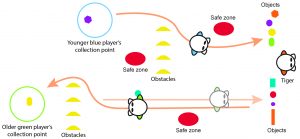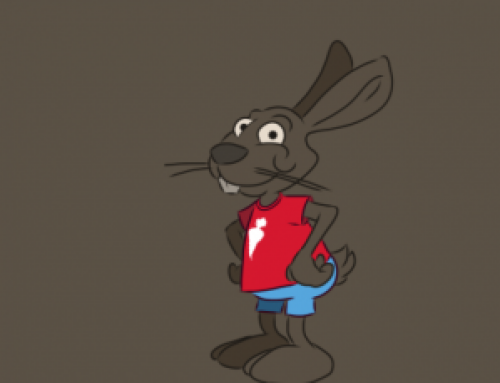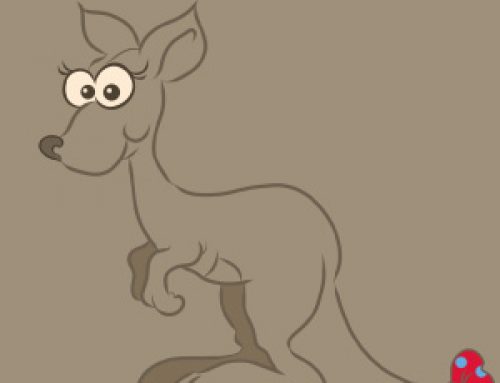Suitable for:
- 2 or more players
- Outdoor or indoor area
- Range of physical literacy: running
- Age appropriate: 3-7 years
Primary physical literacy skill: sidestepping, running, object handling
Make it happen

Build up a simple old fashioned game like ‘What’s the time Mr Wolf?’ to include other elements of physical activity (diagram 1 shows the Basic game; diagram 2 shows all the elements suggested below).
Ages 3-7yrs
- Basic game: the Tiger stands at one end with their back facing the runner(s) who are standing at an opposite end. To win, the runners try to creep up past the tiger while its back is turned. The tiger can turn around at any point and send the runners back to the start if it sees them moving. If they can freeze before being spotted then they get to carry on from where they are.
 Add more elements one by one (diagram 2 shows them all)
Add more elements one by one (diagram 2 shows them all)
- Turn it into a chasing game by adding ‘safe zones’. The tiger can turn around at any point and tag the runners before they get to a safe zone or back to their starting end. The game restarts when the tiger is back in its place.
- Make it a collecting game by adding objects that the runners have to try and collect. You can choose whether to keep safe zones as sanctuaries or whether runners have to make it all the way to a collection point once they have grabbed an object.
- Make it more of a challenge by placing some obstacles (such as marker cones) on the playing area for the children to run around.
- If you are playing with more than 2 children then runners can have a different collection zone each to see who can gather the most. If children are mixed age/ability then place their collection points to take that into account (the diagram shows the green player as an older child and the blue player as a younger child).
- Ensure that the movement the children are performing is suitable for the space you have available.
- Ensure the objects you use are safe for children to run around with in their hands (e.g. soft, lightweight, rounded, no hard edges, etc).
- If you are using a hoop as a safe zone or a collection point then be aware that a hoop placed on a hard surface can cause a slip hazard.
- To avoid any collisions, remind children to always look all around them and to control their speed and direction.
- To prevent head clashes, when children are reaching down to pick objects off the ground remind them not to lean over with their heads down. It’s better if they reach in from the side in a crouched position with their heads out of the way as if feeding meat to a crocodile.
We provide this list only as a guide of what parents/carers may wish to consider. Please also read our general guidelines on the Parents/Carers Information page.
Expand the headings below for suggestions to make more use of this activity and keep you and your children coming back for more
- Ask the children to come up with different themes for the game.
Some ideas: Coral reef – the tiger is a shark and the runners are fishes trying to get food; Serengeti – the tiger is a crocodile and the runners are zebras and wildebeests trying to get across a river.
- Leaper’s theme: Pouncy takes us to a jungle where she challenges us to use our tiger hunting skills and try to steal fruit from her before she can catch us.
Please also read our general guidelines on the Parents/Carers Information page.
- Play each game for a set time period and see who can collect the most objects. Play enough times so everyone gets a turn at being the tiger.
- Give the tiger a limit as to how many times they can turn around per game (e.g. 5) so they have to use their turns wisely.
Please also read our general guidelines on the Parents/Carers Information page.
- Always make sure whatever equipment you are using is safe and appropriate for that use.
- If you don’t have many objects such as tennis balls, sponge balls, bean bags etc, you can use rolled up balls of paper as things to collect.
Please also read our general guidelines on the Parents/Carers Information page.
- Let the tiger choose the type of movement everyone has to use; e.g. skip, hop, jump, crawl on hands and feet, etc. At any time the tiger can call out a different movement type to use.
- If a runner gets tagged, then as well as returning to the start, they have to perform an additional exercise; e.g. 3 star jumps.
Ages 5-7yrs
- If you are playing with 3 or more children, you can have 2 phases. The first is for the runners to steal an object (e.g. a plastic ball) from beside the tiger while its back is turned. The second phase is to keep passing the ball to each other while the tiger tries to tag one of them in possession (or whoever is closest to it if they drop it). The phase continues until someone gets tagged (they then become the next tiger).
Please also read our general guidelines on the Parents/Carers Information page.
Printable PDF download here
Use of the resources
This move to improve resource is provided as a guideline only for parents and carers who wish to supervise physical activities for their children. Users of this resource have a duty of care to ensure the safety of their participants. We do not endorse the use of any content in this resource that a user feels may present a risk to the safety or well being of the children in their care.








